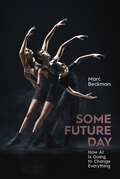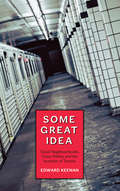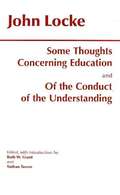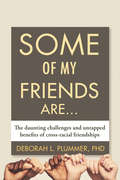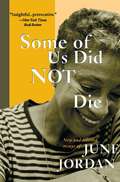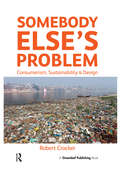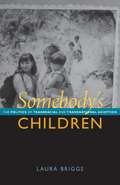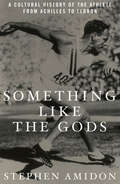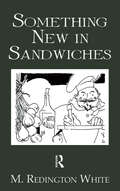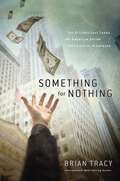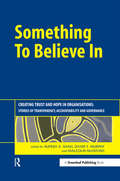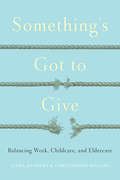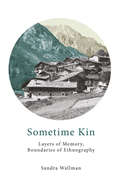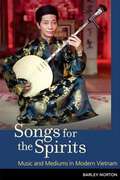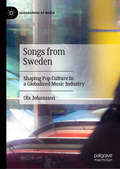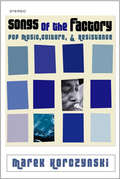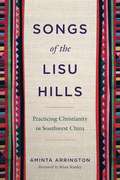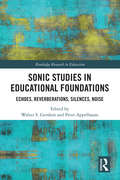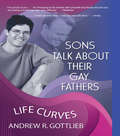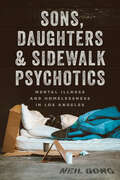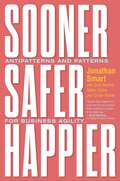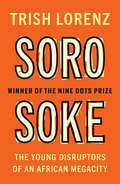- Table View
- List View
Some Future Day: How AI Is Going to Change Everything
by Marc BeckmanThis cutting-edge guide not only shows how AI is transforming our careers, lives, businesses, and more, but also provides easy, actionable steps to make AI work for us. In this groundbreaking book, celebrated professor, entrepreneur, author, and podcaster Marc Beckman explores the transformative power of artificial intelligence (AI) and how it&’s poised to enhance and transform all aspects of society—revolutionizing our careers, enriching our family lives, and bringing our communities closer together. From business and advertising, to medicine, to warfare, to politics—Beckman meticulously explores the different areas where we&’ll soon feel AI&’s transformative impact. But that&’s only half of it. Throughout this book, he also provides the specific steps readers can take now to make sure these coming changes work for them. From the workplace to the home, AI is poised to reshape the way we approach our professional and personal lives. Beckman uses this book to make the case that AI will free up valuable time and energy, allowing individuals to focus on more creative and meaningful work, but also that AI will create possibilities for engagement that were unthinkable just a generation ago. He shows that with AI as our co-pilot, we&’ll unlock new opportunities for growth, innovation, and collaboration—all of which will lead to more fulfilling and rewarding careers. Beckman illustrates how AI will strengthen family bonds and improve the quality of our home lives too, changing everything from how we educate our kids to how we stay connected on social media. And as AI becomes more integrated into our cities and towns, it will play a crucial role in fostering a sense of community and belonging; through AI-powered platforms, Beckman shows how we will collaborate on projects, share resources, and support one another in times of need. This thought-provoking and essential book is a definitive guide to the many ways in which AI will transform our lives for the better . . . but also surprise us, delight us, force us to (re)consider how we interact with one another, and make us question what exactly counts as &“human.&” Join Marc Beckman on this exciting journey as he explores the near-endless possibilities of a world powered and transformed by artificial intelligence. It&’s an Age of Imagination . . . where the only limit is your own mind.
Some Great Idea
by Edward KeenanSince 2010, Toronto's headlines have been consumed by the outrageous personal foibles and government-slashing, anti-urbanist policies of Mayor Rob Ford. But the heated debate at City Hall has obscured a bigger, decade-long narrative of Toronto's ascendance as a mature global city. Some Great Idea traces how post-amalgamation, and under three very different mayors, Toronto managed to so quickly oscillate from one extreme to another, and how the city might proceed from here. Some Great Idea includes behind-the-scenes tales from the Miller and Ford campaigns, and explores recent turning points like the city's core service review and the mayor's con?ict-of-interest trial. Through personal history, keen reportage and revelatory analysis, it shows how the fundamental principles of diversity and democracy that have made Toronto such a vibrant, dynamic 21st-century city can produce an unlikely politician like Ford. And how those same principles have vividly and repeatedly insisted that such politicians are only part of a larger, messier and more productive urban politics. This is a story about both Toronto's past and present, how the city has relentlessly and collaboratively reinvented itself. But it's also a story about Toronto's future, and what that future might mean for all global cities. This is a story that says you can ?ght city hall. Originally announced as a September 2012 publication, Some Great Idea will publish in early 2013 with the most up-to-date information on Toronto's municipal politics.
Some Thoughts Concerning Education and Of The Conduct Of The Understanding
by John LockeThis volume offers two complementary works, unabridged, in modernised, annotated texts -- the only available edition priced for classroom use. Ruth W. Grant and Nathan Tarcov provide a concise introduction, a note on the texts, and a select bibliography.
Some Young People (Selected Works of Pearl Jephcott: Social Issues and Social Research)
by Pearl Jephcott"The Richardson boys ganged up with two other big families in their buildings and, at various ages, had tried out most of the local youth organisations. Bert Richardson with a suitable set of brothers and mates, was in the Scouts, but they got ejected. Later, at thirteen, he joined a boys’ club for its boxing and football, and belonged on and off till he was sixteen. Then he suddenly dropped out." Why did Bert drop out? Originally published in 1954, the answer forms the substance of Some Young People, the report of an inquiry into adolescents’ reactions to their local youth groups. Besides answering the question "Who joins what?" (and two thirds of these thousand youngsters of 14 to 17 were not members of any youth organisation) the book describes some of the hopes, pleasures and difficulties of such people as Frances, the chocolate packer, who has ambition to marry before long; and John, the carpenter’s apprentice, whose passions are autocycling, pigeons and pigs. It also throws light on problems such as those presented by gangs; and suggests the importance of "my friends," the closely-knit set who mean so much to the adolescent.
Some of My Friends Are...: The Daunting Challenges and Untapped Benefits of Cross-Racial Friendships
by Deborah PlummerAn insightful look at how cross-racial friendships work and fail within American society.In a U.S. national survey conducted for this book, 70% of respondents strongly agreed that friendships across racial lines are essential to making progress toward improving race relations. However, further polling found that most Americans tend to gravitate towards friendships within their own racial category.Psychologist, Deborah L. Plummer tells us why that is so. She examines how factors such as leisure, politics, humor, faith, social media, and education influence the nature and intensity of cross-racial friendships. With engaging stories and inspiring anecdotes drawn from national focus groups, interviews, and analyses of survey results of contemporary patterns of adult friendships, she provides insights into the fears and discomforts associated with cross-racial friendships. Through these narratives and social analyses of friendship patterns, Plummer explores how we make connections to form solid bonds, and why it is so challenging to do so across a racial divide. She discusses how we cross that divide and get beyond the prickly uncomfortable moments and have meaningful, enlightening, empathetic conversations about race. With the inclusion of personal stories, this book stirs up authentic racial discourse, prompts readers to examine their own friendship patterns, and encourages us all to create a better path toward a more enlightened future by crossing racial lines in friendship and deepening the strength of current cross-racial friends.
Some of Us Did Not Die: New and Selected Essays
by June Jordan"She remains a thinker and activist who 'insists upon complexity. ' "Reamy Jansen, San Francisco Chronicle*Some of Us Did Not Die brings together a rich sampling of the late poet June Jordan's prose writings. The essays in this collection, which include her last writings and span the length of her extraordinary career, reveal Jordan as an incisive analyst of the personal and public costs of remaining committed to the ideal and practice of democracy. Willing to venture into the most painful contradictions of American culture and politics, Jordan comes back with lyrical honesty, wit, and wide-ranging intelligence in these accounts of her reckoning with life as a teacher, poet, activist, and citizen.
Somebody Else’s Problem: Consumerism, Sustainability and Design
by Robert CrockerGold winner of the AXIOM Business Book Award in the category of Philanthropy, Non-Profit, Sustainability. Please see: http://www.axiomawards.com/77/award-winners/2017-winners Consumerism promises a shortcut to a 'better' life through the accumulation of certain fashionable goods and experiences. Over recent decades, this has resulted in a rising tide of cheap, short-lived goods produced, used and discarded in increasingly rapid cycles, along the way depleting resources and degrading environmental systems.Somebody Else’s Problem calls for a radical change in how we think about our material world, and how we design, make and use the products and services we need. Rejecting the idea that individuals alone are responsible for the environmental problems we face, it challenges us to look again at the systems, norms and values we take for granted in daily life, and their cumulative role in our environmental crisis.Robert Crocker presents an overview of the main forces giving rise to modern consumerism, looks closely at today’s accelerating consumption patterns and asks why older, more ‘custodial’ patterns of consumption are in decline. Avoiding simplistic quick-fix formulas, the book explores recommendations for new ways of designing, making and using goods and services that can reduce our excess consumption, but still contribute to a good and meaningful life.
Somebody’s Children: The Politics of Transnational and Transracial Adoption
by Laura BriggsIn Somebody's Children, Laura Briggs examines the social and cultural forces--poverty, racism, economic inequality, and political violence--that have shaped transracial and transnational adoption in the United States during the second half of the twentieth century and the first decade of the twenty-first. Focusing particularly on the experiences of those who have lost their children to adoption, Briggs analyzes the circumstances under which African American and Native mothers in the United States and indigenous and poor women in Latin America have felt pressed to give up their children for adoption or have lost them involuntarily.The dramatic expansion of transracial and transnational adoption since the 1950s, Briggs argues, was the result of specific and profound political and social changes, including the large-scale removal of Native children from their parents, the condemnation of single African American mothers in the context of the civil rights struggle, and the largely invented "crack babies" scare that inaugurated the dramatic withdrawal of benefits to poor mothers in the United States. In Guatemala, El Salvador, and Argentina, governments disappeared children during the Cold War and then imposed neoliberal economic regimes with U.S. support, making the circulation of children across national borders easy and often profitable. Concluding with an assessment of present-day controversies surrounding gay and lesbian adoptions and the struggles of immigrants fearful of losing their children to foster care, Briggs challenges celebratory or otherwise simplistic accounts of transracial and transnational adoption by revealing some of their unacknowledged causes and costs.
Someone Has to Fail: The Zero-Sum Game of Public Schooling
by David F. LabareeWhat do we really want from schools? Only everything, in all its contradictions. Most of all, we want access and opportunity for all children—but all possible advantages for our own. So argues historian David Labaree in this provocative look at the way “this archetype of dysfunction works so well at what we want it to do even as it evades what we explicitly ask it to do.” Ever since the common school movement of the nineteenth century, mass schooling has been seen as an essential solution to great social problems. Yet as wave after wave of reform movements have shown, schools are extremely difficult to change. Labaree shows how the very organization of the locally controlled, administratively limited school system makes reform difficult. At the same time, he argues, the choices of educational consumers have always overwhelmed top-down efforts at school reform. Individual families seek to use schools for their own purposes—to pursue social opportunity, if they need it, and to preserve social advantage, if they have it. In principle, we want the best for all children. In practice, we want the best for our own. Provocative, unflinching, wry, Someone Has to Fail looks at the way that unintended consequences of consumer choices have created an extraordinarily resilient educational system, perpetually expanding, perpetually unequal, constantly being reformed, and never changing much.
Something Like the Gods: A Cultural History of the Athlete from Achilles to LeBron
by Stephen AmidonA lively, literary exploration of one of the West's most iconic cultural figures—the athlete Why is the athlete so important to us? Few public figures can dominate the public imagination with such power and authority. Even in our cynical times, when celebrities can be debunked at the speed of light, many still look to athletes as models for our moral and emotional lives. An aging fastballer goes for a few last wins in his final season, and he becomes an exemplar for our daily struggles against time. A top golfer cheats on his wife, and his behavior sparks a symposium on marital fidelity more wideranging than if the lapse had come from a politician or religious leader. Drawing from art, literature, politics, and history, Something Like the Gods explores the powerful grip the athlete has always held on the Western imagination. Amidon examines the archetype of the competitor as it evolved from antiquity to the present day, from athlete-warriors such as Achilles and Ulysses to global media icons like Ali, Jordan, and Tiger Woods. Above all, Something Like the Gods is a lyrical study that will appeal to anyone who has ever imagined themselves in the spikes, boots, or sneakers of our greatest athletes—or wondered why people do.
Something New In Sandwiches
by WhiteFirst published in 2005. Routledge is an imprint of Taylor & Francis, an informa company.
Something for Nothing: The All-Consuming Desire that Turns the American Dream into a Social Nightmare
by Brian TracyAmerica's greatness comes from people working hard to fulfill their dreams. But today that greatness is being undermined by people using the government to steal other people's dreams (and money). Rather than participate and innovate in the marketplace, generating goods and services that benefit society, people are increasingly vying for political advantage to live at the expense of others. Something for Nothing reveals the social and personal threats inherent in this emerging "grabbing match" culture, juxtaposing free-market virtues against government vices, explaining how the something-for-nothing mentality corrupts the political system, undermines corporate success, and stifles the individual's ability to prosper and contribute long-term to society. More than exposing the dangers, however, Tracy helps readers set a personal and culture-wide agenda for change.
Something to Believe In: Creating Trust and Hope in Organisations: Stories of Transparency, Accountability and Governance
by Malcolm McIntosh Rupesh A. Shah David F. MurphyIn a world where trust in politicians, corporations and the processes that determine our lives continues to dwindle, this innovative book brings together research, case studies and stories that begin to answer a central question for society: How we can create organisations, institutions, groups and societies that can nurture trusting relationships with one another and among individuals?Something to Believe In provides a fresh take on the corporate responsibility debate, based as it is on the work of key global thinkers on corporate social responsibility, along with a raft of work developed from collaborations between the New Academy of Business and the United Nations Volunteers, UK Department for International Development and TERI-Europe in countries such as Brazil, Nicaragua, Ghana, India, Sri Lanka, Bangladesh, Lebanon, Nigeria, the Philippines and South Africa. The focus is on business, and particularly how deeper, more systemic changes to current ways of understanding and undertaking business can and have been enacted in both developed countries and in nations where the Western concept of CSR means nothing. The market-based model of economic thinking-the increasingly distrusted globalisation project-which threatens to sweep all before it is challenged by many of the contributions to this book.The book tells stories such as the mobilization of civil society in Ghana to bring business to account; the reorientation of a business school to focus on values; the life-cycle of ethical chocolate; the accountability of the diamond business in a war zone; the need to reinvent codes of conduct for women workers in the plantations and factories of Nicaragua; a Philippine initiative to economically empower former Moslem liberation fighters; and the development of local governance practices in a South African eco-village.The book is split into four sections. "Through Some Looking Glasses" contains short, thought-provoking pieces about the issues of trust, belief and change from writers including Thabo Mbeki, Malcolm McIntosh and a reprinted piece from E.M. Forster. Section Two asks how it will be possible to believe in our corporations and provides new approaches from around the world on how space is being opened up to found businesses that are able to create trust. Section Three examines the role of auditing in fostering trust. Corporations continue to attempt to engender trust through their activities in philanthropy, reporting and voluntary programmes. But, post-Enron et al., even the most highly praised corporate mission statements are tarnished. Can social and environmental audits of corporate reports, codes and practices assuage our doubts about boardroom democracy? Section Four examines alternative forms of accountability, transparency and governance from around the world and offers some different ways of thinking about the practice of creating trust in society.Something to Believe In provides a host of fascinating suggestions about redefining and renewing the underlying deal between society and its organizations. It will become a key text for students, thinkers and practitioners in the field of corporate responsibility.
Something's Got to Give: Balancing Work, Childcare and Eldercare
by Chris Higgins Linda DuxburyA perfect storm of factors are brewing that will redefine dependent care in the coming decades. Delayed marriage and parenthood, longer life-spans, lower birthrates, and the health policy shift to informal caregiving have drastically increased the number of employees whose mental and physical health suffers due to an inability to balance work, childcare, and eldercare. Employers also feel the pinch as this inability to balance a myriad of demands is negatively impacting their bottom line. Something’s Got to Give is a comprehensive overview of the challenges faced by employees and employers as they try to respond to this dramatic demographic change. Linda Duxbury and Christopher Higgins utilize an original and rich data set–gathered from 25,000 Canadians who are employed full time in public, private, and not-for-profit organizations--to demonstrate the urgent need for workplace and policy reforms and support for employed caregivers. The authors’ timely work provides practical advice to managers and policy-makers about how to mitigate the effects of employee work-life conflict, retain talent, and improve employee engagement and productivity. Business and labour leaders as well as employees who truly care about their careers and industries can’t afford to ignore the solutions that Something’s Got to Give thoughtfully provides.
Sometime Kin: Layers of Memory, Boundaries of Ethnography
by Sandra WallmanIn Sometime Kin Sandra Wallman paints the portrait of an Alpine settlement – its history, economy and culture, and its unusual resistance to outsiders and modernization. Against this, journal extracts show the villagers embracing her four small children and acting as participant observers in the two-way process of research. This project happened more than forty years ago and involved a uniquely large fieldwork family, but its insights have wider significance. The book argues that the intrusion of observation inevitably distorts the ordinary life observed; that the challenges of multi-vocality and “truth” are always with us; and that memory is the bedrock of every ethnographic enterprise.
Songs for the Spirits: Music and Mediums in Modern Vietnam
by Barley NortonSongs for the Spirits examines the Vietnamese practice of communing with spirits through music and performance. During rituals dedicated to a pantheon of indigenous spirits, musicians perform an elaborate sequence of songs--a "songscape"--for possessed mediums who carry out ritual actions, distribute blessed gifts to disciples, and dance to the music's infectious rhythms. Condemned by French authorities in the colonial period and prohibited by the Vietnamese Communist Party in the late 1950s, mediumship practices have undergone a strong resurgence since the early 1990s, and they are now being drawn upon to promote national identity and cultural heritage through folklorized performances of rituals on the national and international stage. By tracing the historical trajectory of traditional music and religion since the early twentieth century, this groundbreaking study offers an intriguing account of the political transformation and modernization of cultural practices over a period of dramatic and often turbulent transition. An accompanying DVD contains numerous video and music extracts that illustrate the fascinating ways in which music evokes the embodied presence of spirits and their gender and ethnic identities.
Songs from Sweden: Shaping Pop Culture in a Globalized Music Industry (Geographies of Media)
by Ola JohanssonSongs from Sweden shows how Swedish songwriters and producers are the creative forces behind much of today’s international pop music. As Ola Johansson reveals, the roots of this “music miracle” can be found in Sweden’s culture, economy, and thriving music industry, concentrated in Stockholm. While Swedish writer-producers developed early global recognition for making commercially successful pop music, new Swedish writer-producers have continuously emerged during the last two decades. Global artists travel to Stockholm to negotiate, record, and co-write songs. At the same time, Swedish writer-producers are part of a global collaborative network that spans the world. In addition to concrete commercial accomplishments, the Swedish success is also a result of the acquisition of reputational capital gained through positive associations that the global music industry holds about Swedish music. Ultimately, pop songs from Sweden exhibit a form of cultural hybridity, drawing from both local and global cultural expressions.
Songs of the Factory: Pop Music, Culture, and Resistance
by Marek KorczynskiIn Songs of the Factory, Marek Korczynski examines the role that popular music plays in workers' culture on the factory floor. Reporting on his ethnographic fieldwork in a British factory that manufactures window blinds, Korczynski shows how workers make often-grueling assembly-line work tolerable by permeating their workday with pop music on the radio. The first ethnographic study of musical culture in an industrial workplace, Songs of the Factory draws on socio-musicology, cultural studies, and sociology of work, combining theoretical development, methodological innovation, and a vitality that brings the musical culture of the factory workers to life. Music, Korczynski argues, allows workers both to fulfill their social roles in a regimented industrial environment and to express a sense of resistance to this social order. The author highlights the extensive forms of informal collective resistance within this factory, and argues that the musically informed culture played a key role in sustaining these collective acts of resistance. As well as providing a rich picture of the musical culture and associated forms of resistance in the factory, Korczynski also puts forward new theoretical concepts that have currency in other workplaces and in other rationalized spheres of society.
Songs of the Lisu Hills: Practicing Christianity in Southwest China (World Christianity #2)
by Aminta ArringtonThe story of how the Lisu of southwest China were evangelized one hundred years ago by the China Inland Mission is a familiar one in mission circles. The subsequent history of the Lisu church, however, is much less well known. Songs of the Lisu Hills brings this history up to date, recounting the unlikely story of how the Lisu maintained their faith through twenty-two years of government persecution and illuminating how Lisu Christians transformed the text-based religion brought by the missionaries into a faith centered around an embodied set of Christian practices.Based on ethnographic fieldwork as well as archival research, this volume documents the development of Lisu Christianity, both through larger social forces and through the stories of individual believers. It explores how the Lisu, most of whom remain subsistence farmers, have oriented their faith less around cognitive notions of belief and more around participation in a rhythm of shared Christian practices, such as line dancing, attending church and festivals, evangelizing, working in each other’s fields, and singing translated Western hymns. These embodied practices demonstrate how Christianity developed in the mountainous margins of the world’s largest atheist state.A much-needed expansion of the Lisu story into a complex study of the evolution of a world Christian community, this book will appeal to scholars working at the intersections of World Christianity, anthropology of religion, ethnography, Chinese Christianity, and mission studies.
Songs of the Lisu Hills: Practicing Christianity in Southwest China (World Christianity #2)
by Aminta ArringtonThe story of how the Lisu of southwest China were evangelized one hundred years ago by the China Inland Mission is a familiar one in mission circles. The subsequent history of the Lisu church, however, is much less well known. Songs of the Lisu Hills brings this history up to date, recounting the unlikely story of how the Lisu maintained their faith through twenty-two years of government persecution and illuminating how Lisu Christians transformed the text-based religion brought by the missionaries into a faith centered around an embodied set of Christian practices.Based on ethnographic fieldwork as well as archival research, this volume documents the development of Lisu Christianity, both through larger social forces and through the stories of individual believers. It explores how the Lisu, most of whom remain subsistence farmers, have oriented their faith less around cognitive notions of belief and more around participation in a rhythm of shared Christian practices, such as line dancing, attending church and festivals, evangelizing, working in one another’s fields, and singing translated Western hymns. These embodied practices demonstrate how Christianity developed in the mountainous margins of the world’s largest atheist state.A much-needed expansion of the Lisu story into a complex study of the evolution of a world Christian community, this book will appeal to scholars working at the intersections of World Christianity, anthropology of religion, ethnography, Chinese Christianity, and mission studies.
Sonic Studies in Educational Foundations: Echoes, Reverberations, Silences, Noise (Routledge Research in Education)
by Peter Appelbaum Walter S. GershonOriginally published as a special issue of Educational Studies, this volume demonstrates the ways in which sound considerations can significantly contribute to educational foundations. Regardless of their origin or interpretation, sounds are theoretically and practically foundational to educational experiences. As the means through which knowledges are passed from one person to another, sounds outline the fluid, porous boundaries of educational ecologies. This book draws out and expands upon the already-present sonic metaphors that exist at the center of philosophical and historical foundations of educational studies. Contributions demonstrate the ethical dimensions of this line of inquiry, emphasizing the need for education to offer both a right to speak and to be heard in order to take on a truly democratic character. By highlighting emerging attention to sound scholarship in education, contributors attend to and otherwise explore sound possibilities for educational theory, policy, and practice. This book will be of great interest to graduate and post graduate students; libraries, researchers and academics in the field of educational foundations, philosophy of education, education politics and sociology of education.
Sons Talk About Their Gay Fathers: Life Curves
by Andrew GottliebExamine the impact of disclosure on sons whose fathers are gay! In this book, Andrew Gottlieb, author of Out of the Twilight: Fathers of Gay Men Speak, explores yet another side of the impact of homosexuality on families. He now looks at how sons react to learning that their fathers are gay, allowing us to see, over time, how this has changed their family relationships and their own lives. Simply and elegantly written, this psychoanalytically oriented qualitative research study is accessible to both the beginner and the more advanced researcher and practitioner. It draws from a wide range of literary, popular, and psychological sources and includes an interview guide, a reference section, and an index. "When someone discloses as gay, lesbian, or bisexual, it is not just an individual event. It is a family event. Based on estimates of married gay, lesbian, and bisexual persons, a spouse's coming out affects up to 2,000,000 couples. Yet, its impact has been largely ignored. Children&’s voices are the least often heard. . . . Little has been written about sons of fathers who came out during or after marriage. Data for studies that do exist most often draw from the fathers' point of view. . . . The significance of this study lies in its comprehensive, detailed picture of sons and gay fathers as they develop their separate self-images as well as the images of their son-father relationships over time. Painful, sensitive, often triumphant, the stories and [the author&’s] analysis of their thoughts, perceptions, and feelings afford a multidimensional, longitudinal viewing. Step by step, we follow the complicated dance of these sons and fathers as they develop and define their connection." -from the Foreword by Amity Pierce Buxton, Author of The Other Side of the Closet: The Coming-Out Crisis for Straight Spouses and Families Sons Talk About Their Gay Fathers: Life Curves is a storybook-an extended narrative moved along, but not overshadowed, by psychoanalytic theory. The Introduction briefly reviews more recent writings of the fathering experience as told by gay men themselves, setting the stage for: "Father to Child"-a look at the father as seen through the ever-shifting eyes of his son at different phases of the life cycle "The Quest for the Real Father"-an examination of sons' responses to their fathers' homosexuality as captured in film, fiction, nonfiction, television, and the psychological literature "Methodology"-the story of the research process, including sampling, the search for subjects, trustworthiness, the interview, bias, and data collection "The Stories"-an anthology of narratives the author constructed from the interview material, painting an intimate portrait of each individual son "Findings"-a categorical analysis "Discussion"-a summary of all the preceding material cast in a developmental framework, highlighting implications for future research and clinical practice
Sons, Daughters, and Sidewalk Psychotics: Mental Illness and Homelessness in Los Angeles
by Neil GongSociologist Neil Gong explains why mental health treatment in Los Angeles rarely succeeds, for the rich, the poor, and everyone in between. In 2022, Los Angeles became the US county with the largest population of unhoused people, drawing a stark contrast with the wealth on display in its opulent neighborhoods. In Sons, Daughters, and Sidewalk Psychotics, sociologist Neil Gong traces the divide between the haves and have-nots in the psychiatric treatment systems that shape the life trajectories of people living with serious mental illness. In the decades since the United States closed its mental hospitals in favor of non-institutional treatment, two drastically different forms of community psychiatric services have developed: public safety-net clinics focused on keeping patients housed and out of jail, and elite private care trying to push clients toward respectable futures. In Downtown Los Angeles, many people in psychiatric crisis only receive help after experiencing homelessness or arrests. Public providers engage in guerrilla social work to secure them housing and safety, but these programs are rarely able to deliver true rehabilitation for psychological distress and addiction. Patients are free to refuse treatment or use illegal drugs—so long as they do so away from public view. Across town in West LA or Malibu, wealthy people diagnosed with serious mental illness attend luxurious treatment centers. Programs may offer yoga and organic meals alongside personalized therapeutic treatments, but patients can feel trapped, as their families pay exorbitantly to surveil and “fix” them. Meanwhile, middle-class families—stymied by private insurers, unable to afford elite providers, and yet not poor enough to qualify for social services—struggle to find care at all. Gong’s findings raise uncomfortable questions about urban policy, family dynamics, and what it means to respect individual freedom. His comparative approach reminds us that every “sidewalk psychotic” is also a beloved relative and that the kinds of policies we support likely depend on whether we see those with mental illness as a public social problem or as somebody’s kin. At a time when many voters merely want streets cleared of “problem people,” Gong’s book helps us imagine a fundamentally different psychiatric system—one that will meet the needs of patients, families, and society at large.
Sooner Safer Happier: Antipatterns and Patterns for Business Agility
by Jonathan Smart"This is one of the most important Agile books since The Phoenix Project." —Charles Betz, Principle Analyst, Forrester ResearchIt's no secret that we are living in the Digital Age. Technology companies make up seven of the world's ten largest firms by market capitalization. And the key to their success is the key to all modern organizations. Jonathan Smart, business agility practitioner, thought leader, and coach, reveals the patterns and antipatterns that will help organizations from every industry deliver better value sooner, safer, and happier through high levels of engagement, inclusion, and empowerment. Through his decades of experience in the technology world, Smart provides business leaders with a blueprint for creating a world-class organization of the future. Through Agile and Lean ways of working, business leaders can empower teams to improve production, grow together, and create better services for their customers. These better ways of working have overflowed from the IT department to every corner of successful organizations, taking root in every industry from aerospace to accounting, insurance to shipping.This book is not about software development. It is not a book about the computer industry. This book is about applying agility across the entire organization. It's a book that will put you at the front of change and ahead of the competition."A true business-wide perspective on Digital Transformation and the need for whole business agility." —Adam Banks, Non Executive Director and Former CTIO of AP Moller Maersk**Note from the Authors: Purchases will result in the planting of trees and empowerment of women, in countries with the lowest scores on the IUCN's gender and environment index. It's not just carbon neutral, purchases in any format will result in, on average, 10x greater carbon offset.
Soro Soke: The Young Disruptors of an African Megacity
by Trish LorenzFor the first time in human history, people aged over 65 now outnumber children under five. Yet one region in the world is bucking this trend: the world's top 20 youngest countries by population are all located in sub-Saharan Africa, and Africa's population under 35 now equals almost a billion people. Whilst there has been much research and reportage in the West around the lives of millennials and Gen Z, little has been written on the dreams and aspirations, the fears and hopes, the needs and desires of young Africans. The Yoruba expression Soro Soke, meaning “Speak Up”, has become a clarion call for young Nigerians seeking to make their voices heard, resonating across the African continent and around the world via social media. Trish Lorenz speaks to the bright new entrepreneurs, artists, and activists of Lagos and Abuja, Nigeria, to understand what it means to be young in an otherwise ageing world. This book is also available Open Access.
